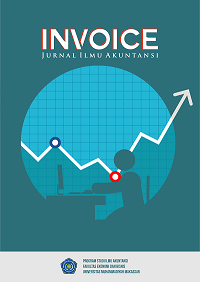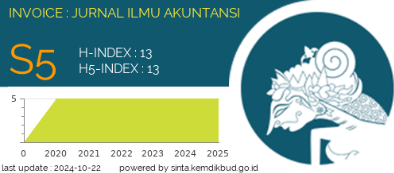The Effect of Implementing a Corporate Resource Management System (ERP) in Improving PT's Supply Chain Management (SCM) Performance. Sat Nusapersada Tbk
DOI: https://doi.org/10.26618/inv.v6i1.14372
Abstrak
This research investigates the effect of implementing an Enterprise Resource Management System (ERP) on improving Supply Chain Management (SCM) performance at PT. Sat Nusapersada Tbk. With the research method in the form of interviews, information was obtained from the company owner. The results show that ERP implementation has a significant positive influence on SCM performance at PT. Nusapersada Sat. In facing global competition, SCM is an important key in achieving competitive advantage. ERP helps facilitate a company's internal integration, enabling more effective supply chain management. This study concludes that ERP integration provides significant benefits in increasing company operational efficiency, increasing customer satisfaction, increasing revenue and profits, and optimizing asset use. However, to improve overall SCM performance, wise decision making, effective communication, and good coordination between ERP and SCM are required. Therefore, continuous efforts are needed to improve the system to achieve more optimal results.Referensi
Alshawabkeh, R. O. K., Al-Awamleh, H. K., Alkhawaldeh, M. I. G., Kanaan, R. K., Al-Hawary, S. I. S., Mohammad, A. A. S., & Alkhawaldah, R. A. (2022). The mediating role of supply chain management on the relationship between big data and supply chain performance using SCOR model. Uncertain Supply Chain Management, 10(3), 729–736. https://doi.org/10.5267/j.uscm.2022.5.002
Abdullah, I., Firdaus, A., & Marsuni, N. S. (2023). Entrepreneurial Success Examined through Social Capital and Entrepreneurial Competence among MSME Operators in the PTB Tourist Attraction in Maros City. Economos: Jurnal Ekonomi dan Bisnis, 6(3), 219-232.
Alshurideh, M. T., Al Kurdi, B., Alzoubi, H. M., Ghazal, T. M., Said, R. A., AlHamad, A. Q., Hamadneh, S., Sahawneh, N., & Al-kassem, A. H. (2022). Fuzzy assisted human resource management for supply chain management issues. Annals of Operations Research. https://doi.org/10.1007/s10479-021-04472-8
Calystania, V., Hasvia, T. G., Jones, J. H., Bhuan, S., & Valentino, J. (2022). Volume 14 Issue 2 ( 2022 ) Pages 479-486 JURNAL MANAJEMEN ISSN : 2085-6911 ( Print ) 2528-1518 ( Online ) Analisis manfaat penerapan manajemen rantai pasok dan ERP An analysis of benefits implementing supply chain management and ERP. 14(2), 479–486.
Craig, C., & Driscoll, O. (2016). City Research Online City , University of London Institutional Repository. International Journal of Infectious Diseases, 57, 265–274. https://doi.org/10.1016/j.ijid.2016.10.011
Cuandra, F., Maytanius, J., Leonardo, Sembiring, D. T., & Lim, R. (2022). Pengaruh Manajemen Rantai Pasok Berbasis Erp Dalam Meningkatkan Kinerja Pt. Furnitur Batam Bina Perkasa. Transekonomika: Akuntansi, Bisnis Dan Keuangan, 2(4), 55–60. https://doi.org/10.55047/transekonomika.v2i4.141
Dewi, R. P. A., & Suprapti, I. (2022). Analisis Manajemen Rantai Pasok dan Efisiensi Pemasaran Keripik Jagung UD. Tajul Anwar Jaya. Agriscience, 2(3), 743–761. https://doi.org/10.21107/agriscience.v2i3.13831
Fikri, M. A., & Rini, P. L. (2023). Manajemen Rantai Pasokan Hijau dan Kinerja Bisnis : Peran Kinerja Operasional Pada Sektor Industri Produk Halal. 9(01), 358–370.
Huang, L., Zhen, L., Wang, J., & Zhang, X. (2022). Blockchain implementation for circular supply chain management: Evaluating critical success factors. Industrial Marketing Management, 102(99), 451–464. https://doi.org/10.1016/j.indmarman.2022.02.009
Jamaludin, M. (2021). Desain Sistem Informasi Manajemen Rantai Pasok pada PT “ABCD” Bandung Jawa Barat Indonesia. Jurnal Administrasi Bisnis, 10(2), 143–154. https://doi.org/10.14710/jab.v10i2.36302
Khairunissa, A., & Santosa, W. (2022). Volume . 18 Issue 3 ( 2022 ) Pages 611-621 INOVASI : Jurnal Ekonomi , Keuangan dan Manajemen ISSN : 0216-7786 ( Print ) 2528-1097 ( Online ) Pengaruh eko-efisiensi terhadap kinerja keberlanjutan dengan mediasi manajemen rantai pasok hijau pada perusahaan logistik di Indonesia The effect of eco-efficiency on sustainability performance by mediation of green supply chain management in logistics companies in Indonesia. 18(3), 611–621.
Koberg, E., & Longoni, A. (2019). A systematic review of sustainable supply chain management in global supply chains. Journal of Cleaner Production, 207, 1084–1098. https://doi.org/10.1016/j.jclepro.2018.10.033
Lia, S. (2022). No Titleהכי קשה לראות את מה שבאמת לנגד העינים. הארץ, 3(8.5.2017), 2003–2005. https://www.who.int/news-room/fact-sheets/detail/autism-spectrum-disorders
Management, S. C., & Journal, I. (2018). ha y C pl up in en t : a n I nt er tio na l J na r ou na p up ain Ch ly na me nt : a n I nt ern on al ur Jo na.
Marsuni, N. S. (2024). Enhancing Accountability through the Application of Sharia Accounting Principles: A Case Study of Baznas Makassar City. JEKAMI Journal of Accounting, 4(1), 31-36.
Marsuni, N. S., Arum, R. A., Mariana, L., & Nersiyanti, N. (2023). Abnormal Comparison Analysis of Return and Trading Volume Activity Before and After The Announcement of The Covid 19 Pandemic. Economos: Jurnal Ekonomi dan Bisnis, 6(3), 276-285.
Marbun, D. S., Effendi, S., Lubis, H. Z., & Pratama, I. (2020). Role of education management to expediate supply chain management: A case of Indonesian higher educational institutions. International Journal of Supply Chain Management, 9(1), 89–96.
Min, S., Zacharia, Z. G., & Smith, C. D. (2019). Defining Supply Chain Management: In the Past, Present, and Future. Journal of Business Logistics, 40(1), 44–55. https://doi.org/10.1111/jbl.12201
Nasrullah, N., Mariana, L., Marsuni, N. S., & Dharma, S. (2023). The Influence of Soft Skills and Adversity Quotient on Work Readiness of Students in the Faculty of Economics at Muhammadiyah University Makassar. Economos: Jurnal Ekonomi dan Bisnis, 6(3), 247-258.
Planning, C., Planning, C., Operasional, K., & Kecil, U. M. (2022). JBEE : Journal Business Economics and Entrepreneurship TERHADAP KINERJA OPERASIONAL PADA UMKM. 4(2).
Putro, P. A. W., Purwaningsih, E. K., Sensuse, D. I., Suryono, R. R., & Kautsarina. (2021). Model and implementation of rice supply chain management: A literature review. Procedia Computer Science, 197(2021), 453–460. https://doi.org/10.1016/j.procs.2021.12.161
Qadri, R. A., Cuandra, F., Tina, T., & ... (2022). Analisis Strategi Dan Penggunaan Erp Dalam Manajemen Rantai Pasokan Walmart. … Management …, 2(1), 72–80. https://ojs.stieamkop.ac.id/index.php/biemr/article/view/157%0Ahttps://ojs.stieamkop.ac.id/index.php/biemr/article/download/157/73
Rantai, M., Terhadap, P., Organisasi, K., & Korespondensi, E. P. (2022). 1* , 2 1,2. 16(2), 234–246.
Richey, R. G., Roath, A. S., Adams, F. G., & Wieland, A. (2022). A Responsiveness View of logistics and supply chain management. Journal of Business Logistics, 43(1), 62–91. https://doi.org/10.1111/jbl.12290
Romanto, F., Handoko, F., & Kiswandono. (2022). Metode Supply Chain Operation Reference (Scor) Sebagai Analisis Kinerja Manajemen Rantai Pasok Di Pabrik Gula Pandjie. Jurnal Valtech, 5(1), 107–113. https://ejournal.itn.ac.id/index.php/valtech/article/view/4628
Sahid, A. (2022). Peran Enterprise Resource Planning dan Strategi Bisnis Terhadap Integrasi Manajemen Rantai Pasok dan Kepuasan Pelanggan Pada Industri Pertahanan. Journal of Industrial Engineering & Management …, 3(6), 42–50. https://jiemar.org/index.php/jiemar/article/view/326%0Ahttps://jiemar.org/index.php/jiemar/article/download/326/249
Sharma, R., Shishodia, A., Gunasekaran, A., Min, H., & Munim, Z. H. (2022). The role of artificial intelligence in supply chain management: mapping the territory. International Journal of Production Research, 60(24), 7527–7550. https://doi.org/10.1080/00207543.2022.2029611
Subagyono, K. (2023). Pengaruh manajemen rantai pasok berkelanjutan terhadap kinerja organisasi yang dimediasi manajemen hubungan pelanggan dan keunggulan kompetitif pada perusahaan otomotif. 3(2).
Voicu, B., Şerban, M., Tudor, E., & Deliu, A. (2013). Acquiescence effects in measuring attitudes towards immigrants: The case of Romania. Calitatea Vietii, 2013(3), 311–340.
Wullur, M., B Sumarauw, J. S., Manajemen, J., & Ekonomi dan Bisnis, F. (2022). Identifikasi Desain Jaringan Manajemen Rantai Pasok Arang Tempurung Kelapa Di Masa Pandemi Covid-19 (Studi Kasus Di Desa Tatakalai Kecamatan Tinangkung Utara) Identify Network Design Supply Chain Management of Coconut Shell Charcoal During the Covid-19 Pandemic (Case Study in Tatakalai Village North Tinangkung District). 96 Jurnal EMBA, 10(2), 96–105.
Zai, I., Laulita, N. B., Nurhidayati, M., Riana, S. F., Jacelyn, Widiana, P. T., & Saputra, T. A. H. (2022). Penerapan Manajemen Rantai Pasok Berbasis Sistem ERP Dalam Meningkatkan Kinerja UMKM Rumah Makan Has Seven. EKOMA: Jurnal Ekonomi, Manajemen, Akuntansi, 1(2), 223–233. http://ulilalbabinstitute.com/index.php/EKOMA/article/view/360
Unduhan
Diterbitkan
Terbitan
Bagian
Lisensi
Authors who publish with Invoice: Jurnal Ilmu Akuntansi agree to the following terms:
-
Copyright Ownership
The copyright of all articles published in this journal remains with the author(s). However, the authors grant Invoice: Jurnal Ilmu Akuntansi the right of first publication with the work simultaneously licensed under a Creative Commons Attribution 4.0 International License (CC BY 4.0). This license allows others to share, copy, redistribute, adapt, and build upon the work for any purpose, even commercially, as long as proper credit is given to the original author(s) and the source. -
Licensing and Access
Invoice: Jurnal Ilmu Akuntansi provides immediate open access to its content on the principle that making research freely available to the public supports a greater global exchange of knowledge. All published materials are available freely without subscription or payment and can be accessed, downloaded, and reused by any user provided that appropriate attribution is given. -
Permission for Reuse
For uses not covered by the CC BY 4.0 license, such as commercial reprints, translations, or any form of adaptation without clear attribution, users must obtain written permission from the editorial team. Requests for such permissions can be directed to the editorial office at: [invoice@unismuh.ac.id]. -
Plagiarism and Originality
Authors are responsible for the originality of their submissions. All articles are screened for plagiarism using appropriate tools before acceptance. Manuscripts found to contain unoriginal content or infringing materials will be rejected or retracted as per journal policy.














